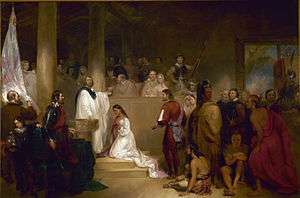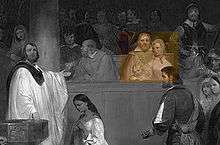Mistress Forrest
Mistress Forrest[1] (Margaret Foxe) and her maid servant Anne Burras, were the first two women to come to the Virginia Colony, arriving on October 1, 1608 in what is known as the Second Supply, aboard the English ship the Mary and Margaret (or Mary-Margaret, both names appear in the records) under Captain Christopher Newport to resupply the colony at Jamestown, Virginia. Her husband Thomas Forrest (colonist) Esq. was listed as a gentleman on that ship as shown on its manifest, whereas she was listed only as Mistress Forrest.[2] Thomas and Margaret had married on August 16, 1605, in St. Giles in the Fields, London, England.[3]
 Colonial History by Captain John Smith 1624
Colonial History by Captain John Smith 1624
Excavation at Jamestown
Remains unearthed at Jamestown in 1997 may be those of Mistress Forrest.
"Dr. Doug Owsley and Karin Bruwelheide of the Smithsonian Institute [sic] examined the skeleton in the field. Their preliminary conclusions were that JR156C was a caucasian woman, about 35 years old. She was very small, possibly only about 4'9" or so in height. She had only 5 teeth at the time of her death, the rest having been lost many years before. The cause of her death was not evident. Stable isotope analysis done on the bones indicated that she had a diet primarily of wheat, rather than corn. This usually indicates a recently landed European."Documents indicate that the first women at Jamestown were Mistress Forest and her maid Anne Burras, who landed with the Second Supply in 1608. Anne Burras is known to have married John Laydon, and both were listed in the 1625 muster. Mistress Forrest, probably the wife of gentleman Thomas Forrest, is not mentioned again in the historical record, and may have died soon after her arrival at Jamestown. Scholars speculate that JR156 could be the grave of Mistress Forrest."[4]
To see a photograph of the facial reconstruction of JR156, go to http://archive.archaeology.org/image.php?page=9903/newsbriefs/jpegs/jamestown.jpeg
Thomas and Mistress Forrest in a painting, Baptism of Pocahontas, in the Rotunda of the US Capital Building
In February 1837, John Gadsby Chapman received a commission from the United States Congress to paint a historical scene for the rotunda of the Capitol building. For this work, Chapman received a total payment of $10,000. On November 30, 1840, The Baptism of Pocahontas was formally unveiled in the Capitol rotunda.

Prominently featured in the painting, according to a "key" from the Granger Collection, New York City is "11. Mr. and Mrs. Forrest, the lady being the first gentlewoman to arrive in the colony", and the painting itself shows a man, woman and young child, presumably their son (although there is no record of Margaret and Thomas having any children, while there is a record of Thomas having a son, Peter born in 1601).

This key is referenced "At Jamestown VA 1613". It is unlikely this historic painting done over two centuries later reflects the actual history: The Smithsonian's JR156 excavation of the female skeleton suggests it was the remains of Mistress Forrest who "may have died soon after her arrival in Jamestown" in 1608, thus would not have been not alive to witness a 1613 baptism. Further, the child born in 1601 would not be a toddler 12 years later. Never-the-less, the painting firmly places Thomas Forrest, and perhaps his son Peter, in the rotunda of American History as art, if not fact.
References
- ↑ "Jamestown's First Lady - Archaeology Magazine Archive". archaeology.org. Retrieved 2017-08-11.
- ↑ "John Smith, 1580-1631. The Generall Historie of Virginia, New-England, and the Summer Isles: With the Names of the Adventurers, Planters, and Governours From Their First Beginning Ano: 1584. To This Present 1624. With the Procedings of Those Severall Colonies and the Accidents That Befell Them in All Their Journyes and Discoveries. Also the Maps and Descriptions of All Those Countryes, Their Commodities, People, Government, Customes, and Religion Yet Knowne. Divided Into Sixe Bookes. By Captaine Iohn Smith, Sometymes Governour in Those Countryes & Admirall of New England". docsouth.unc.edu. Retrieved 2017-08-11.
- ↑ Barnes, R.W. (2007). Colonial Families of Maryland: Bound and Determined to Succeed. Clearfield. p. 86. ISBN 9780806353166. Retrieved 2017-08-11.
- ↑ Jamestown Rediscovery, Burial JR 156C http://www.preservationvirginia.org/finding/jr156c.html?process=0